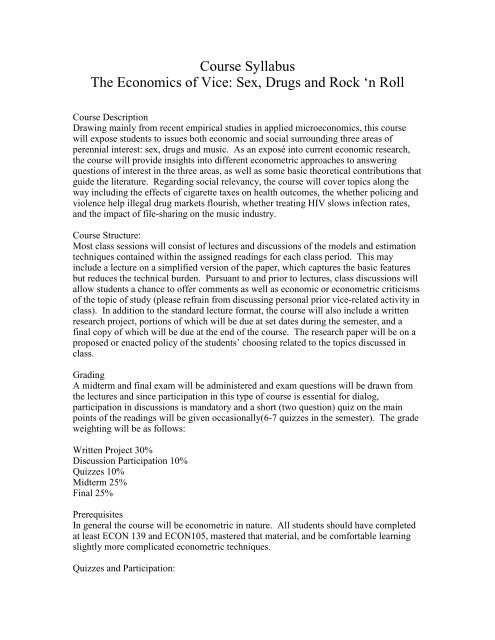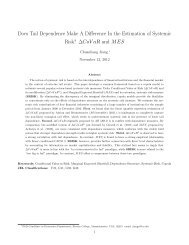Course Syllabus The Economics of Vice: Sex, Drugs and Rock 'n Roll
Course Syllabus The Economics of Vice: Sex, Drugs and Rock 'n Roll
Course Syllabus The Economics of Vice: Sex, Drugs and Rock 'n Roll
You also want an ePaper? Increase the reach of your titles
YUMPU automatically turns print PDFs into web optimized ePapers that Google loves.
<strong>Course</strong> <strong>Syllabus</strong><br />
<strong>The</strong> <strong>Economics</strong> <strong>of</strong> <strong>Vice</strong>: <strong>Sex</strong>, <strong>Drugs</strong> <strong>and</strong> <strong>Rock</strong> ‘n <strong>Roll</strong><br />
<strong>Course</strong> Description<br />
Drawing mainly from recent empirical studies in applied microeconomics, this course<br />
will expose students to issues both economic <strong>and</strong> social surrounding three areas <strong>of</strong><br />
perennial interest: sex, drugs <strong>and</strong> music. As an exposé into current economic research,<br />
the course will provide insights into different econometric approaches to answering<br />
questions <strong>of</strong> interest in the three areas, as well as some basic theoretical contributions that<br />
guide the literature. Regarding social relevancy, the course will cover topics along the<br />
way including the effects <strong>of</strong> cigarette taxes on health outcomes, the whether policing <strong>and</strong><br />
violence help illegal drug markets flourish, whether treating HIV slows infection rates,<br />
<strong>and</strong> the impact <strong>of</strong> file-sharing on the music industry.<br />
<strong>Course</strong> Structure:<br />
Most class sessions will consist <strong>of</strong> lectures <strong>and</strong> discussions <strong>of</strong> the models <strong>and</strong> estimation<br />
techniques contained within the assigned readings for each class period. This may<br />
include a lecture on a simplified version <strong>of</strong> the paper, which captures the basic features<br />
but reduces the technical burden. Pursuant to <strong>and</strong> prior to lectures, class discussions will<br />
allow students a chance to <strong>of</strong>fer comments as well as economic or econometric criticisms<br />
<strong>of</strong> the topic <strong>of</strong> study (please refrain from discussing personal prior vice-related activity in<br />
class). In addition to the st<strong>and</strong>ard lecture format, the course will also include a written<br />
research project, portions <strong>of</strong> which will be due at set dates during the semester, <strong>and</strong> a<br />
final copy <strong>of</strong> which will be due at the end <strong>of</strong> the course. <strong>The</strong> research paper will be on a<br />
proposed or enacted policy <strong>of</strong> the students’ choosing related to the topics discussed in<br />
class.<br />
Grading<br />
A midterm <strong>and</strong> final exam will be administered <strong>and</strong> exam questions will be drawn from<br />
the lectures <strong>and</strong> since participation in this type <strong>of</strong> course is essential for dialog,<br />
participation in discussions is m<strong>and</strong>atory <strong>and</strong> a short (two question) quiz on the main<br />
points <strong>of</strong> the readings will be given occasionally(6-7 quizzes in the semester). <strong>The</strong> grade<br />
weighting will be as follows:<br />
Written Project 30%<br />
Discussion Participation 10%<br />
Quizzes 10%<br />
Midterm 25%<br />
Final 25%<br />
Prerequisites<br />
In general the course will be econometric in nature. All students should have completed<br />
at least ECON 139 <strong>and</strong> ECON105, mastered that material, <strong>and</strong> be comfortable learning<br />
slightly more complicated econometric techniques.<br />
Quizzes <strong>and</strong> Participation:
Roughly twelve short (less that 10 minute) quizzes will be administered throughout the<br />
semester. <strong>The</strong> quizzes will ask questions regarding the assigned reading <strong>and</strong> serve to<br />
ensure active fulfillment <strong>of</strong> the reading requirements. <strong>The</strong> lowest two quiz scores will be<br />
dropped. <strong>The</strong> participation score is designed to encourage in-class discussion <strong>of</strong> the<br />
economic <strong>and</strong> social issues studied in the papers.<br />
Exams:<br />
<strong>The</strong> exams will be based on lectures <strong>and</strong> the reading material. Mathematical questions<br />
will mainly be drawn from the less complicated lectures. However the papers must be<br />
read, <strong>and</strong> topics <strong>and</strong> ideas not covered in class will be tested. Since many <strong>of</strong> the same<br />
estimation techniques will be used, the exams are in this sense cumulative<br />
Written Project<br />
Within the first two weeks <strong>of</strong> class each student will discuss with me via email or in<br />
person the policy they are interested in studying. <strong>The</strong> first two sections <strong>of</strong> the written<br />
project will be the same for all students; the third section can be one <strong>of</strong> two options. <strong>The</strong><br />
first section is to be a compilation <strong>and</strong> summary <strong>of</strong> non-economic research <strong>and</strong><br />
information surrounding the policy <strong>of</strong> interest. <strong>The</strong> research should draw from related<br />
fields, e.g. medicine, public health, industry reports, legal <strong>and</strong>/or business history,<br />
sociology, <strong>and</strong> any other relevant field as well as popular media. <strong>The</strong> goal <strong>of</strong> this first<br />
section is to give a broad underst<strong>and</strong>ing <strong>of</strong> where this policy fits in history <strong>and</strong> society.<br />
<strong>The</strong> second section will be a very detailed analysis <strong>of</strong> economic research on this <strong>and</strong><br />
closely related policies. This section will give in-depth reviews on the econometric <strong>and</strong><br />
theoretical work on these policies; it should include some technical details which<br />
demonstrate the student underst<strong>and</strong>s what insights economic analysis adds to our overall<br />
knowledge <strong>of</strong> the policy <strong>and</strong> its consequences, both intended <strong>and</strong> unintended. Finally the<br />
last section will either take the form <strong>of</strong> a presentation or another written section. <strong>The</strong><br />
presentation will be via power point <strong>and</strong> be aimed at a non-economic audience, the goal<br />
being to help students develop their ability to communicate economic research. <strong>The</strong> other<br />
option for the third section is for the student to engage in original research on their topic<br />
<strong>of</strong> interest, which will require gathering data, coming up with an empirical strategy for<br />
underst<strong>and</strong>ing the policy effects, <strong>and</strong> carrying out the analysis.<br />
Procedures<br />
Each <strong>of</strong> the written sections should be around 10 pages (st<strong>and</strong>ard fonts <strong>and</strong> margins), <strong>and</strong><br />
the presentation should be around 30-35 minutes. After written sections are turned in I<br />
will give feedback on what should be changed/improved, <strong>and</strong> the final copy, due the last<br />
day before the final exam, should address the changes.<br />
Due Dates(tentative)<br />
1 st Section Thursday Feb 12<br />
2 nd Section Thursday Mar 26<br />
Some Suggested Policies for Projects:<br />
Cigarette Sales Taxes<br />
Smoking Bans<br />
Drug legalization<br />
Alcohol regulation
<strong>Sex</strong> Education/condom distribution<br />
Effects <strong>of</strong> abortion legalization on social outcomes<br />
Altering copyright laws<br />
Digital media innovations’ effect on music industry<br />
Suggested Textbooks(not required):<br />
A Guide to Econometrics, 5 th Edition. Peter Kennedy, ISBN: 0-262-61183<br />
-This book is a very good <strong>and</strong> intuitive guide through econometrics with detailed<br />
references. I will suggest readings from this book to review or introduce the<br />
econometric concepts we will cover in class. Purchasing this book is a great<br />
substitute for trying to remember all <strong>of</strong> econometrics.<br />
Reading List by Section<br />
Rational Addiction <strong>and</strong> Smoking<br />
(3 weeks)<br />
Readings:<br />
I. Overview<br />
Tobacco at the Crossroads: <strong>The</strong> Past <strong>and</strong> Future <strong>of</strong> Smoking Regulation in the<br />
United States<br />
Gruber,-Jonathan<br />
Journal-<strong>of</strong>-Economic-Perspectives. Spring 2001; 15(2): 193-212<br />
http://www.jstor.org/view/08953309/di021425/02p0030f/0#&origin=sfx%3Asfx<br />
Policy Watch: Alcohol <strong>and</strong> Cigarette Taxes<br />
M Grossman, JL Sindelar, J Mullahy, R Anderson<br />
<strong>The</strong> Journal <strong>of</strong> Economic Perspectives, 1993 Vol. 7, No. 4. (Autumn, 1993), pp.<br />
211-222.<br />
Stable URL: http://links.jstor.org/sici?sici=0895-<br />
3309%28199323%297%3A4%3C211%3APWAACT%3E2.0.CO%3B2-V<br />
II. Testing Competing Models<br />
An Empirical Analysis <strong>of</strong> Cigarette Addiction<br />
Becker,-Gary-S; Grossman,-Michael; Murphy,-Kevin-M<br />
American-Economic-Review. June 1994; 84(3): 396-418<br />
Cigarette smoking <strong>and</strong> self-control<br />
Kamhon Kan<br />
Journal <strong>of</strong> Health <strong>Economics</strong><br />
Volume 26, Issue 1, January 2007, Pages 61-81<br />
Are Smokers Misinformed?<br />
Ahmed Khwaja, Dan Silverman, <strong>and</strong> Frank Sloan<br />
Mimeo 2007<br />
<strong>The</strong> compensating behavior <strong>of</strong> smokers: taxes, tar <strong>and</strong> nicotine<br />
Evans, Willian, Farrelly Matthew<br />
RAND Journal <strong>of</strong> <strong>Economics</strong>
Taxes, Cigarette Consumption <strong>and</strong> Smoking Intensity<br />
Adda, Jeroma, Cornaglia, Francesca<br />
AER 2006<br />
Illicit <strong>Drugs</strong><br />
(4 Weeks)<br />
Readings:<br />
I. Drug Dem<strong>and</strong><br />
Adolescent Alcohol <strong>and</strong> Marijuana Consumption: Is <strong>The</strong>re Really a Gateway<br />
Effect?<br />
Rosalie Liccardo Pacula<br />
NBER Working Paper No. 6348<br />
Issued in January 1998<br />
https://wwww.nber.org/papers/w6348<br />
Alcohol <strong>and</strong> marijuana use among college students: economic complements or<br />
substitutes?<br />
J Williams, R Liccardo Pacula, FJ Chaloupka, H … - Health <strong>Economics</strong>, 2004 -<br />
doi.wiley.com<br />
http://www3.interscience.wiley.com/cgi-bin/fulltext/107061902/PDFSTART<br />
<strong>The</strong> Dem<strong>and</strong> for Illicit <strong>Drugs</strong><br />
Saffer,-Henry; Chaloupka,-Frank<br />
National Bureau <strong>of</strong> Economic Research, Inc, NBER Working Papers: 5238 1995<br />
http://www.nber.org/papers/w5238.pdf?new_window=1<br />
Alcohol, Marijuana, <strong>and</strong> American Youth: <strong>The</strong> Unintended Consequences <strong>of</strong><br />
Government Regulation<br />
DiNardo,-John; Lemieux,-Thomas<br />
Journal-<strong>of</strong>-Health-<strong>Economics</strong>. November 2001; 20(6): 991-1010 A<br />
http://www.sciencedirect.com/science?_ob=MImg&_imagekey=B6V8K-447N1RD-6-<br />
42&_cdi=5873&_user=38557&_orig=search&_coverDate=11%2F30%2F2001&_qd=1&_sk=999799993&view=c&wchp<br />
=dGLbVlz-zSkzk&md5=d7d02450785a60d8113d1c6e420f8a10&ie=/sdarticle.pdf<br />
Read Ch 2. Ken Train, Discrete Choice Methods<br />
http://elsa.berkeley.edu/choice2/ch2.pdf<br />
<strong>Sex</strong><br />
(4 Weeks)<br />
Readings:<br />
I. Pregnancy <strong>and</strong> Abortion<br />
Did Legalized Abortion Lower Crime?<br />
Ted Joyce<br />
<strong>The</strong> Journal <strong>of</strong> Human Resources, Vol. 39, No. 1. (Winter, 2004), pp. 1-28.
Further Evidence that Legalized Abortion Lowered Crime: A Reply to Joyce<br />
John J. Donohue III; Steven D. Levitt<br />
Journal <strong>of</strong> Human Resources , (May, 2004)<br />
Further Tests <strong>of</strong> Abortion <strong>and</strong> Crime<br />
Joyce, Ted<br />
NBER Working Paper 10564<br />
Adolescent Premarital Childbearing: Do Economic Incentives Matter?<br />
Shelly Lundberg; Robert D. Plotnick<br />
Journal <strong>of</strong> Labor <strong>Economics</strong> > Vol. 13, No. 2 (Apr., 1995), pp. 177-200<br />
Should I stay or Should I Go? Abortion Dem<strong>and</strong> <strong>and</strong> Relationship Dissolution.<br />
Andrew Beauchamp (2007), working paper.<br />
II. Reasons for Risky <strong>Sex</strong> Behavior<br />
Competing for the Opposite <strong>Sex</strong>: An Equilibrium Model <strong>of</strong> High School Dating<br />
<strong>and</strong> <strong>Sex</strong> Behavior<br />
Arcidiacono-Peter, Beauchamp-Andrew, McElroy-Marjorie<br />
Working paper 2006.<br />
Habit Persistence <strong>and</strong> Teen <strong>Sex</strong>: Could Increased Access to Contraception have<br />
Unintended Consequences for Teen Pregnancies?<br />
Arcidiacono-Peter, Khwaja -Ahmed <strong>and</strong> Ouyang -Lijing<br />
Duke University, Working paper<br />
http://www.econ.duke.edu/~psarcidi/addicted13.pdf<br />
III. Problems in HIV Prevention<br />
When Knowledge Is Not Enough: HIV/AIDS Information <strong>and</strong> Risky Behavior in<br />
Botswana<br />
Levinsohn,-James-A; Dinkelman,-Taryn<br />
National Bureau <strong>of</strong> Economic Research, Inc, NBER Working Papers: 12418 2006<br />
http://www.nber.org/papers/w12418.pdf<br />
HIV Breakthroughs <strong>and</strong> Risky <strong>Sex</strong>ual Behavior<br />
Lakdawalla,-Darius; Sood,-Neeraj; Goldman,-Dana<br />
Quarterly-Journal-<strong>of</strong>-<strong>Economics</strong>. August 2006; 121(3): 1063-1102<br />
http://www.mitpressjournals.org/doi/pdfplus/10.1162/qjec.121.3.1063<br />
<strong>Rock</strong> ‘n <strong>Roll</strong><br />
(3 Weeks)<br />
Readings:<br />
I. Overview<br />
<strong>Rock</strong>onomics: <strong>The</strong> <strong>Economics</strong> <strong>of</strong> Popular Music<br />
Connolly,-Marie; Krueger,-Alan-B<br />
National Bureau <strong>of</strong> Economic Research, Inc, NBER Working Papers: 11282 2005
II. File Sharing <strong>and</strong> Music Dem<strong>and</strong><br />
Piracy <strong>and</strong> the Legitimate Dem<strong>and</strong> for Recorded Music(tentative)<br />
Hui,-Kai-Lung; Png,-Ivan<br />
Contributions-to-Economic-Analysis-<strong>and</strong>-Policy. 2003; 2(1):<br />
http://proquest.umi.com/pqdlink?Ver=1&Exp=12-14-<br />
2011&FMT=7&DID=686503971&RQT=309&clientId=15020&cfc=1<br />
<strong>The</strong> Effect <strong>of</strong> File Sharing on Record Sales: An Empirical Analysis<br />
Koleman Strumpf <strong>and</strong> F. Oberholzer<br />
Working paper, 2005<br />
http://www.unc.edu/~cigar/papers/FileSharing_June2005_final.pdf<br />
Piracy on the High C's: Music Downloading, Sales Displacement, <strong>and</strong> Social<br />
Welfare in a Sample <strong>of</strong> College Students<br />
Rob,-Rafael; Waldfogel,-Joel<br />
National Bureau <strong>of</strong> Economic Research, Inc, NBER Working Papers: 10874 2004<br />
http://papers.nber.org/papers/w10874.pdf?new_window=1<br />
III. Models <strong>of</strong> Music Industry <strong>and</strong> Piracy<br />
Peer-to-Peer File Sharing: <strong>The</strong> Case <strong>of</strong> the Music Recording Industry (tentative)<br />
Alex<strong>and</strong>er,-Peter-J<br />
Review-<strong>of</strong>-Industrial-Organization. March 2002; 20(2): 151-61<br />
http://proquest.umi.com/pqdlink?Ver=1&Exp=12-14-2011&FMT=7&DID=417551651&RQT=309&clientId=15020

















